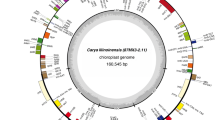Summary
A physical map of the Bromus inermis chloroplast genome was constructed using heterologous probes of barley and wheat chloroplast DNA (cpDNA) to locate restriction sites. The map was aligned from data obtained from filter hybridization experiments on single and double enzyme digests. Cleavage sites for the enzymes PstI, SalI, KpnI, XhoI and PvuII were mapped. The chloroplast genome of B. inermis is similar in physical organization to that of other grasses. The circular cpDNA molecule of B. inermis has the typical small (12.8 kbp) and large (81.3 kbp) single-copy regions separated by a pair of inverted repeat (21 kbp) regions. The cpDNA molecule of B. inermis is collinear in sequence to that of wheat, rye, barley and oats. No structural rearrangements or major deletions were observed, indicating that the cpDNA of Bromus is a useful tool in phylogenetic studies.
Similar content being viewed by others
References
Armstrong KC (1973) Chromosome pairing in hexaploid hybrids from Bromus erectus x B. inermis (2n = 56). Can J Genet Cytol 15:427–436
Armstrong KC (1977) Hybrids of the annual Bromus arvensis with perennial B. inermis and B. erectus. Can J Genet Cytol 21:65–71
Armstrong KC (1981) The evolution of Bromus inermis and related species of Bromus sect. Pragma. Bot Jahrb Syst 102:427–443
Armstrong KC (1982) Hybrids between the tetraploids of Bromus inermis and Bromus pumpellianus. Can J Bot 60:476–482
Armstrong KC (1983) The relationship between some Eurasian and American species of Bromus section Pnigma as determined by the karyotypes of some F1 hybrids. Can J Bot 61:700–707
Armstrong KC (1984 a) Chromosome pairing affinities between old and new world species of Bromus section Pnigma. Can J Bot 62:581–585
Armstrong KC (1984 b) The genomic relationship of the diploid Bromus variegatus to Bromus inermis. Can J Genet Cytol 26(4):469–474
Armstrong KC (1985) Chromosome pairing in octoploid F1 and octoploid amphiploid hybrids between Bromus inermis and B. pumpellianus. Can J Genet Cytol 27:538–541
Baum BR, Bailey LG (1989) Species relationships in the Hordeum murinum aggregate viewed from chloroplast DNA restriction patterns. Theor Appl Genet 78:311–317
Bowman CM, Dyer TA (1982) Purification and analysis of DNA from wheat chloroplast isolated in nonaqueous media. Anal Biocheml 22:108–118
Bowman CM, Koller B, Delius H, Dyer TA (1981) A physical map of wheat chloroplast DNA showing the location of the structural genes for the ribosomal RNAs and the large subunit of ribulose 1,5-bisphosphate carboxylase. Mol Gen Genet 65:247–262
Dally AM, Second G (1990) Chloroplast DNA diversity in wild and cultivated species of rice (genus Oryza, section Oryza): cladistic-mutation and genetic-distance analysis. Theor Appl Genet 80:209–222
Day A, Ellis THN (1985) Deleted forms of plastid DNA in albino plants from cereal anther culture. Curr Genet 9:671–678
Enomoto S, Ogihara Y, Tsunewaki K (1985) Studies on the origin of crop species by restriction endonuclease analysis of organellar DNA. I. Phylogenetic relationships among ten cereals revealed by the restriction fragment patterns of chloroplast DNA. Jpn J Genet 60:411–424
Green RM, Vardi A, Galun E (1986) The plastome of Citrus: physical map, variation among Citrus cultivars and species and comparison with related genera. Theor Appl Genet 72:170–177
Howe CJ, Barker RF, Bowman CM, Dyer TA (1988) Common features of three inversions in wheat chloroplast DNA. Curr Genet 13:343–349
Kellogg EA (1992) Tools for studying the chloroplast genome in the Triticeae (Gramineae): an EcoRI map, a diagnostic deletion, and support for Bromus as an outgroup. Am J Bot 79:186–197
Kemble RJ (1987) A rapid, single leaf, nucleic acid assay for determining the cytoplasmic organelle component of rapeseed and related Brassica species. Theor Appl Genet 73:364–370
Maniatis T, Fritsch EF, Sambrook J (1982) Molecular cloning: a laboratory manual. Cold Spring Harbor Laboratory Press, Cold Spring Harbor, N.Y.
Molnar SJ (1988) Smooth bromegrass (Bromus inermis Leyss). In: Bajaj YPS (ed) Biotechnology in agriculture and forestry vol. 6. Springer, Berlin Heidelberg New York, pp 428–443
Murai K, Tsunewaki K (1987) Chloroplast genome evolution in the genus Avena. Genetics 116:613–621
Murai K, Naiyu Xu, Tsunewaki K (1989) Studies on the origin of crop species by restriction endonuclease analysis of organellar DNA. III. Chloroplast DNA variation and interspecific relationships in the genus Secale. Jpn J Genet 64:35–47
Nei M, Li W-H (1979) Mathematical models for studying genetic variation in terms of restriction endonucleases. Proc Natl Acad Sci USA 76:5269–5273
Newell LC (1973) Smooth bromegrass. In: Heath ME, Metcalfe DS, Barnes RF (eds) Forages: the science of grassland agriculture, 3rd edn. Iowa State University Press, Ames, Iowa, pp 254–262
Ogihara Y, Tsunewaki K (1982) Molecular basis of the genetic diversity of the cytoplasm in Triticum and Aegilops. I. Diversity of the chloroplast genome and its lineage revealed by the restriction pattern of ct-DNAs. Jpn J Genet 57:371–396
Ogihara Y, Tsunewaki K (1988) Diversity and evolution of chloroplast DNA in Triticum and Aegilops as revealed by restriction fragment analysis. Theor Appl Genet 76:321–332
Palmer JD (1986) Isolation and structural analysis of chloroplast DNA. In: Weissbach A, Weissbach H (eds) Methods in enzymology vol 118. Academic Press, New York, pp 167–186
Pillay M, Hilu KW (1990) Chloroplast DNA variation in diploid and polyploid species of Bromus (Poaceae) subgenera Festucaria and Ceratochloa. Theor Appl Genet 80:326–332
Poulsen C (1983) The barley chloroplast genome: physical structure and transcriptional activity in vivo. Carlsberg Res Commun 48:57–80
Reed KC, Mann DA (1985) Rapid transfer of DNA from agarose gels to nylon membranes. Nucleic Acids Res 13:7207–7221
Rigby PWJ, Dieckmann M, Rhodes C, Berg P (1977) Labelling deoxyribonucleic acid to high specific activity in vitro by nick translation with DNA polymerase I. J Mol Biol 113:237–251
Soreng RJ, Davis JI, Doyle JJ (1990) A phylogenetic analysis of chloroplast DNA restriction site variation in Poaceae subfamily Pooideae. Plant Syst Evol 172:83–97
Author information
Authors and Affiliations
Additional information
Communicated by P.L. Pfahler
Rights and permissions
About this article
Cite this article
Pillay, M. Chloroplast genome organization of bromegrass, Bromus inermis Leyss. Theoret. Appl. Genetics 86, 281–287 (1993). https://doi.org/10.1007/BF00222089
Received:
Accepted:
Issue Date:
DOI: https://doi.org/10.1007/BF00222089




